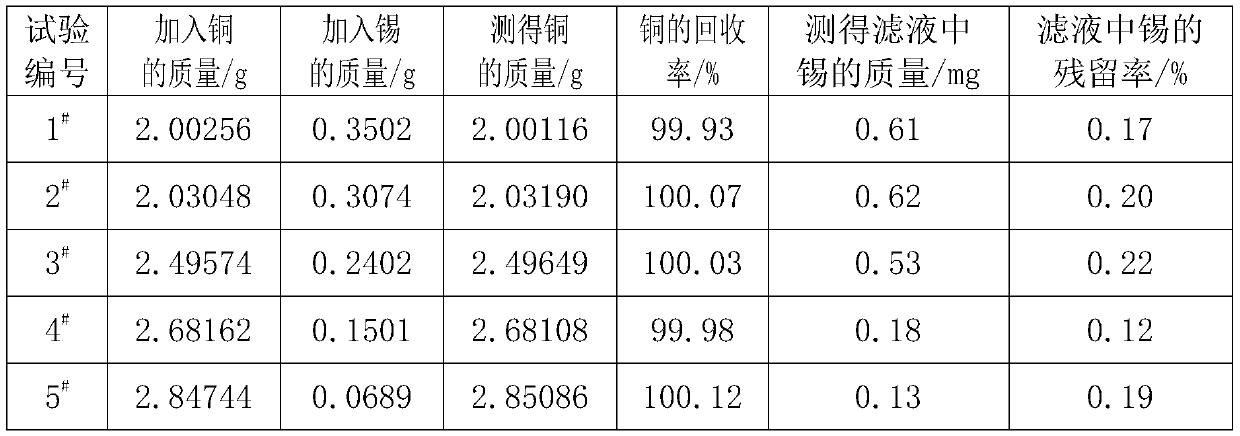Analysis method for determining copper content in high-tin scrap copper ingots and crude copper
An analysis method, a technology of waste miscellaneous copper, which is applied in the direction of chemical analysis, measuring device, and analysis material by titration method, which can solve the problems that the analysis speed cannot meet the production needs, the interference of copper measurement is not considered, and the analysis process is long. Achieve the effects of easy mastering, improved precision and accuracy, and wide applicability
- Summary
- Abstract
- Description
- Claims
- Application Information
AI Technical Summary
Problems solved by technology
Method used
Image
Examples
Embodiment
[0044] Embodiment: a specific embodiment of the present invention is as follows:
[0045] 1. Reagents, instruments and equipment:
[0046] According to a specific embodiment of the present invention, the analytical method for measuring the amount of copper in high-tin waste miscellaneous copper ingots and blister copper requires reagents, instruments and equipment:
[0047] Unless otherwise stated, only reagents of confirmed analytical grade and deionized or distilled or equivalently pure water were used in the analysis.
[0048] Pure copper sheet (ω Cu ≥99.999%); potassium iodide; anhydrous sodium carbonate; absolute ethanol; hydrochloric acid (ρ1.19g / mL); nitric acid (ρ1.42g / mL); nitric acid solution (volume ratio of nitric acid and water is 1:1); nitric acid solution (volume ratio of nitric acid and water is 1:99); sulfuric acid (ρ1.84g / mL); nitric acid mixed acid (volume ratio of nitric acid and sulfuric acid is 7:3); bromine saturated solution; hydrogen peroxide (mass p...
test approach 22
[0105] According to test method 2.2, change the concentration of nitric acid and observe the dissolution of the sample. The results are shown in Table 1.
[0106] Table 1 Nitric acid selection of different concentrations (n=5)
[0107] serial number Nitric acid and water volume ratio / (40mL) Response speed 1 1+0 violent, splash 2 1+1 fast 3 1+2 slow 4 1+3 slow 5 1+4 very slow
[0108] It can be seen from Table 1 that the speed of the reaction is more appropriate when using nitric acid solution (the volume ratio of nitric acid and water is 1:1) to dissolve the sample. Therefore, nitric acid (the volume ratio of nitric acid and water is 1:1) was used to dissolve the sample in the test.
[0109] 4.2 The choice of the amount of nitric acid and water with a volume ratio of 1:1:
test approach 22
[0110] According to test method 2.2, change the amount of nitric acid solution (the volume ratio of nitric acid and water is 1:1), and observe the dissolution of the sample. The results are shown in Table 2.
[0111] Table 2 nitric acid and water volume ratio is the influence of adding amount of 1:1 (n=5)
[0112] serial number Amount added / mL Dissolving effect 1 10 partially undissolved 2 20 partially undissolved 3 30 to dissolve 4 40 to dissolve 5 50 to dissolve
[0113] It can be seen from Table 2 that the sample can be dissolved by adding 30mL, 40mL, and 50mL. Therefore, the nitric acid solution (the volume ratio of nitric acid and water is 1:1) was selected as 40mL in the test.
[0114] 4.3 Interference test of tin on the determination of copper by iodometric method:
[0115] Carry out according to the test method 2.1, and calculate the recovery rate of copper, investigate the influence of tin on the determination of c...
PUM
 Login to View More
Login to View More Abstract
Description
Claims
Application Information
 Login to View More
Login to View More - R&D
- Intellectual Property
- Life Sciences
- Materials
- Tech Scout
- Unparalleled Data Quality
- Higher Quality Content
- 60% Fewer Hallucinations
Browse by: Latest US Patents, China's latest patents, Technical Efficacy Thesaurus, Application Domain, Technology Topic, Popular Technical Reports.
© 2025 PatSnap. All rights reserved.Legal|Privacy policy|Modern Slavery Act Transparency Statement|Sitemap|About US| Contact US: help@patsnap.com



